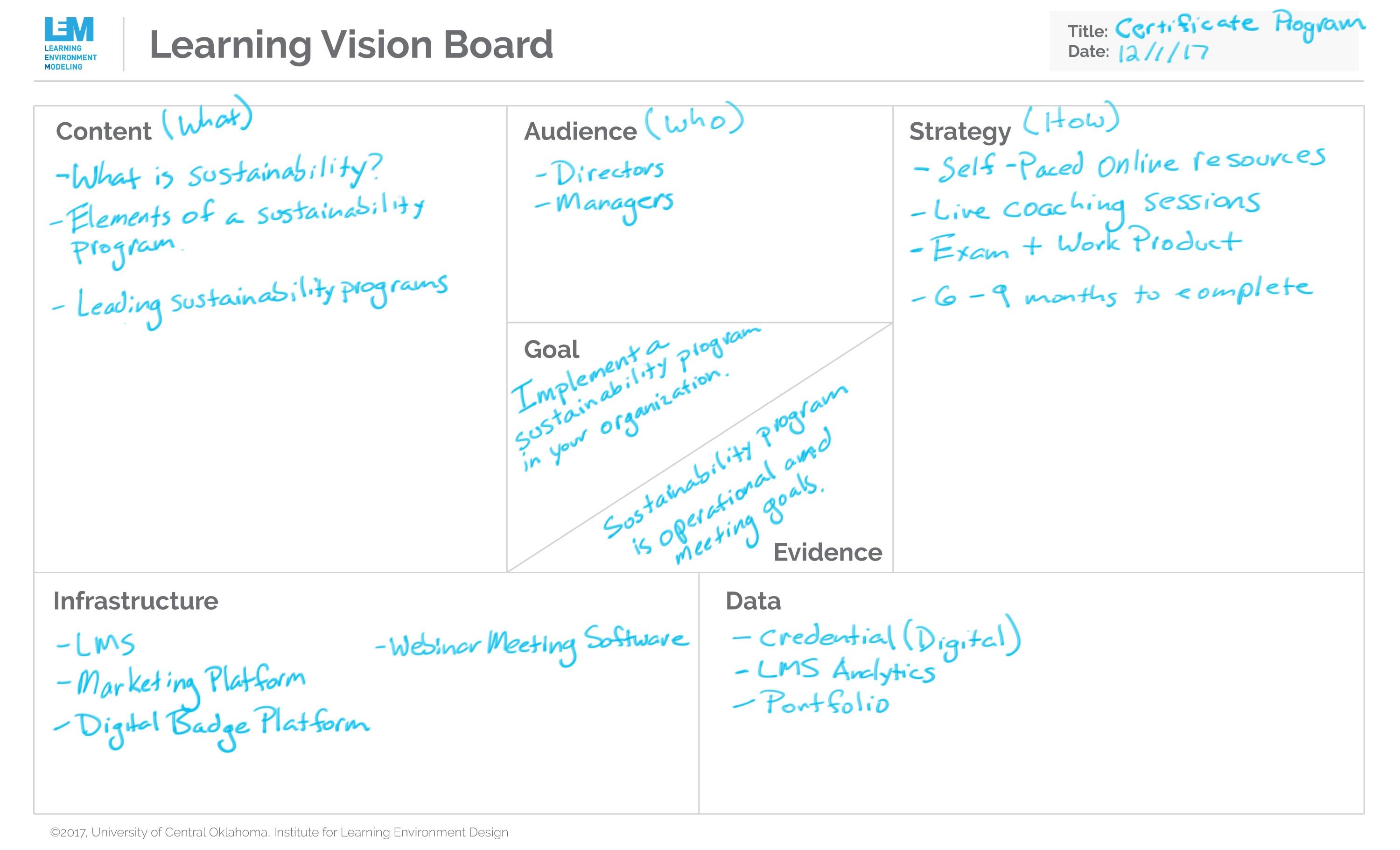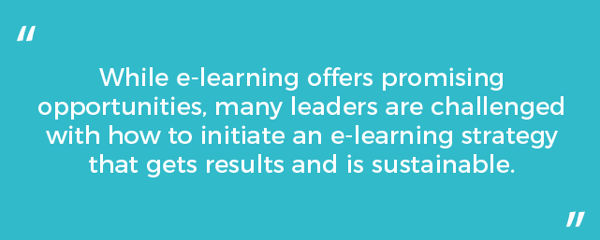The most important role leaders today fill is to manage their organization’s learning initiatives. This means more than providing opportunities and learning objectives - they must design experiences that are both practical and accessible. They’re responsible for creating organic learning opportunities and finding dynamic ways for others to participate in their own progress.
Why Do You Need an E-Learning Strategy?
For many organizations, this means exploring the role elearning plays in meeting the learning needs of employees and association members. In addition to the learning benefits, successful elearning can open a new revenue stream and growth opportunities for associations by engaging with real professionals who contribute. Online courses, training modules, and association online presences can all be utilized to improve member participation.
It can be easy to say, “Let’s get into elearning,” but this goal can be much more complicated than many leaders realize. Online learning is more than technology; it requires creating new value for your organization and your association’s members. Any successful elearning effort requires a strong vision, a supportive strategy, and members and leaders with the initiative to follow through on it.
The Advantages of E-Learning
An elearning strategy offers new ways of reaching learners and creating new value. Advantages can include:
- Better learning outcomes
- Growing registrations for member education
- Higher satisfaction with continuing education programs
- A wider audience for learning opportunities creating more revenue
Let’s look at how a great strategy can do all of this.
Accessibility & Flexibility for Members
eLearning describes ways of supporting learning experiences using a broad portfolio of digital delivery methods. This often takes on the form of online courses and lessons or online training, but can also include mobile learning and more advanced technologies like virtual reality.
The many web-based platforms and digital learning solutions available today make elearning flexible and accessible. Learning management systems (LMS) provide central hubs where online learning courses can be built and curated by staff and easily accessed by students.
The capabilities of your LMS should allow you to create online education materials and resources that can be easily modified to fit your association’s and members’ goals. Its primary focus should be to provide your members an excellent user experience. That can be attained through accessibility and flexibility to give them a more satisfying learning experience.
Social media platforms allow educators to provide an extremely accessible and effective virtual classroom. For example, by simply signing in with LinkedIn, educators and learners can find users who are real professionals that contribute and share reliable content. If educators use their LinkedIn account or other social media platforms with thought and care, it can be a useful and even priceless tool.
Creating Value for Members
Creating value for members means giving them something a little bit extra. You can do this with elearning courses. Online courses and training can utilize engaging teaching tools not available in traditional education to help students and trainees learn better in more interesting ways.
The value is in using elearning to more effectively teach so that learners are more successful in their learning and come away with a better understanding of the subject matter.
Growing Your Membership
Creating value doesn’t have to be limited to existing members. You can give your association value in the eyes of potential members too by offering eLearning opportunities through different learning technologies and extended enterprises.
This can be done with goals in mind for marketing, talent acquisition, or talent development. When individuals see the quality learning experiences you offer, they will want to join or otherwise work with your association.
5 Steps to Creating an E-Learning Strategy

While elearning offers promising opportunities, many leaders are challenged with how to initiate a strategy that gets results and is sustainable. The complexity involved with creating a successful strategy can be overwhelming and there are relatively few practical resources to help.
The Learning Vision Board can be used for planning elearning. This tool breaks down learning strategies into manageable decision points that all support a broader vision and was designed to help leaders consider the essential elements needed to implement a successful strategy for their organization.
The Learning Vision Board organizes the core components of a learning vision around a goal and evidence. The content, audience, strategy, infrastructure, and data are all connected to the goal and evidence and are used to support a vision for learning. For example, a goal is meaningless if it does not align with what the audience needs and wants from a learning experience. Furthermore, the infrastructure needs to be in place to provide the capacity to support these efforts.
One of the major considerations that arise when creating your strategy for elearning is how all the pieces work together to support your organization's goals and the goals of the learner. To achieve this, your strategy should create a unified learning environment that is connected and optimized for your organization. The Learning Vision Board helps to align these core elements so your elearning efforts get results.

1) Set your goals and how you will measure progress
Your first step in creating an elearning strategy is to make goals so you and your team know what you’re working towards. This means looking at “why” you’re adopting elearning and what you hope to accomplish by doing so. From there you can identify clear goals and learning objectives that follow the reasons for using elearning and inform every future decision during the process.
Often the goals are financial.
You should also establish a means for measuring your progress. What evidence is required for you to know that you are moving towards meeting your goals? Consider what signs or accomplishments will signify that you are moving forward.
By establishing early on what your goals are and what the evidence of progress will look like, you will be able to gauge how well your plan is working as you work towards implementing elearning for your association and make changes to support success as needed.
2) Define your audience
You’ve probably heard the term “know your audience.” It applies to many situations, including your strategy for elearning. Many decisions made while you’re planning and implementing elearning courses will depend on who they are for. It will be easier for you to make these decisions when you have a clear definition of who your elearning efforts are meant to benefit in the end and what their needs are.
3) Decide on your content
The needs of your audience will largely decide your content. What do they need to learn? What is the best way to teach the course material? What is the best web-based environment for them to learn in? What learning technologies will best meet their learning needs? What support can we provide them? Will social learning add to the experience?
Content can be delivered via videos with interactive graphic design that keeps the learner motivated. Self-assessments can be used to provide learners a pause for reflection and an opportunity to apply their knowledge and test their understanding. Incorporating discussions can offer learners a chance to share their experience and ideas and encourage collaboration with real professionals who contribute. Bottom line is, creating engaging elearning content can increase motivation and promote a more effective elearning experience for your audience.
There will be a lot of “what” questions about your content. Fortunately, for every question, there are elearning design strategies that provide solutions as you explore the best ways to deliver an effective learning environment for your members.
4) Set up your data & infrastructure.
The “how” of setting up your data and infrastructure may be daunting at first, but that’s where a great learning management system (LMS) comes into play. Your LMS will be an elearning environment for members and an analytics tool for you. It will provide the platform where you build and house your online courses and materials and where students will access them.
A good LMS is necessary for effectively doing everything required of an elearning association, so it’s important to find one with all the capabilities you need to provide learners with engaging learning features and track student performance and activities. Pick the right LMS while still strategizing to make all future elearning management that much easier.
5) Fine-tuning your strategy
With the basics out of the way, it’s time to look at the smaller details of your strategy and make decisions on how your elearning courses should work for students. For instance, should courses be self-paced or guided? Will video content be all pre-recorded or will there be live elements? How long should it take to complete a lesson or a course?
Now is when you’re in the nitty-gritty of what will make your online courses successful. Keep in mind everything you laid out in the first four steps to give yourself guidance. Most importantly, always remember the initial goals you set for elearning.
Partner with a Learning Designer
It’s one thing to put on paper a goal to implement elearning for your association, but it’s another to truly put it into action. That’s why creating a strategy is so important. It bridges a single idea and the action. That still doesn’t make it easy though.
What does make it easier? Working with a learning designer.
An experienced learning designer knows all the ins and outs of creating the best elearning environment for your association. They know how to use all the offerings of LMS platforms and tools to help you meet your goals of increased value and membership for your association.
The best learning outcomes come from expert strategy implementation. Learning designers curate a successful strategy for elearning through content development, smart course design, and curriculum development.
If you’re ready to get your elearning strategy going, NextThought invites you to talk to us about your association’s goals and how we can make them happen.

Dr. Bucky Dodd
Bucky Dodd holds a Ph.D. in Education from Oklahoma State University, an M.Ed. in Adult Education and B.A. in Corporate Communication from the University of Central Oklahoma. He has experience with leading innovative instructional design initiatives in higher education, government, and corporate settings. Bucky’s research focuses on innovation and decision-making in instructional design and the design of blended learning systems. He is passionate about reading, learning new things, and sharing that knowledge with others.
Recent Posts

How can L&D support well-being for resilient employees and sustainable careers?
January 27, 2023 3 Min Read
.png?)




